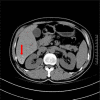One case of iodine-125 therapy - A new minimally invasive treatment of intrahepatic cholangiocarcinoma
- PMID: 36249528
- PMCID: PMC9518658
- DOI: 10.1515/biol-2022-0473
One case of iodine-125 therapy - A new minimally invasive treatment of intrahepatic cholangiocarcinoma
Abstract
Intrahepatic cholangiocarcinoma (ICC) is the second most common primary liver cancer associated with a poor prognosis. ICC accounts for about 10% of primary liver malignancies but with increasing incidence in recent years. Recently, some studies suggested that minimally interventional therapy can be used in the treatment of ICC. However, there are few references on interventional therapy for the clinical treatment of ICC. Herein we reported a case of a 48-year-old man who suffered from ICC. The patient was diagnosed with ICC by computerized tomography scan and pathological biopsy. The patient was completely cured by minimally interventional therapy with iodine-125 seed implantation. These results provide an important reference for the treatment option of ICC.
Keywords: intrahepatic cholangiocarcinoma; iodine-125; transcatheter arterial chemoembolization.
© 2022 Xinju Chen et al., published by De Gruyter.
Conflict of interest statement
Conflict of interest: Authors state no conflict of interest.
Figures






Similar articles
-
Case: Authentic multimodal therapy and liver resection for an initially unresectable intrahepatic cholangiocarcinoma.Int J Surg Case Rep. 2018;51:409-414. doi: 10.1016/j.ijscr.2018.08.059. Epub 2018 Sep 15. Int J Surg Case Rep. 2018. PMID: 30273909 Free PMC article.
-
Multidisciplinary approaches to intrahepatic cholangiocarcinoma.Cancer. 2013 Nov 15;119(22):3929-42. doi: 10.1002/cncr.28312. Epub 2013 Aug 20. Cancer. 2013. PMID: 23963845 Review.
-
Adjuvant Transarterial Chemoembolization Following Liver Resection for Intrahepatic Cholangiocarcinoma Based on Survival Risk Stratification.Oncologist. 2015 Jun;20(6):640-7. doi: 10.1634/theoncologist.2014-0470. Epub 2015 May 8. Oncologist. 2015. PMID: 25956404 Free PMC article.
-
The clinical characteristics and prognostic factors of combined Hepatocellular Carcinoma and Cholangiocarcinoma, Hepatocellular Carcinoma and Intrahepatic Cholangiocarcinoma after Surgical Resection: A propensity score matching analysis.Int J Med Sci. 2021 Jan 1;18(1):187-198. doi: 10.7150/ijms.50883. eCollection 2021. Int J Med Sci. 2021. PMID: 33390787 Free PMC article.
-
Current management of intrahepatic cholangiocarcinoma: from resection to palliative treatments.Radiol Oncol. 2020 Jul 29;54(3):263-271. doi: 10.2478/raon-2020-0045. Radiol Oncol. 2020. PMID: 32726292 Free PMC article. Review.
Cited by
-
Iodine-125 seed inhibits proliferation and promotes apoptosis of cholangiocarcinoma cells by inducing the ROS/p53 axis.Funct Integr Genomics. 2024 Jun 12;24(3):114. doi: 10.1007/s10142-024-01392-1. Funct Integr Genomics. 2024. PMID: 38862667 Free PMC article.
References
-
- Spratt B, Kozan E, Sinnott M. Analysis of uncertainty in the surgical department: Durations, requests and cancellations. Aust Health Rev. 2019;43(6):706–11. - PubMed
-
- Ierardi AM, Angileri SA, Patella F, Panella S, Lucchina N, Petre EN, et al. The role of interventional radiology in the treatment of intrahepatic cholangiocarcinoma. Med Oncol. 2017;34(1):11. - PubMed
Publication types
LinkOut - more resources
Full Text Sources
